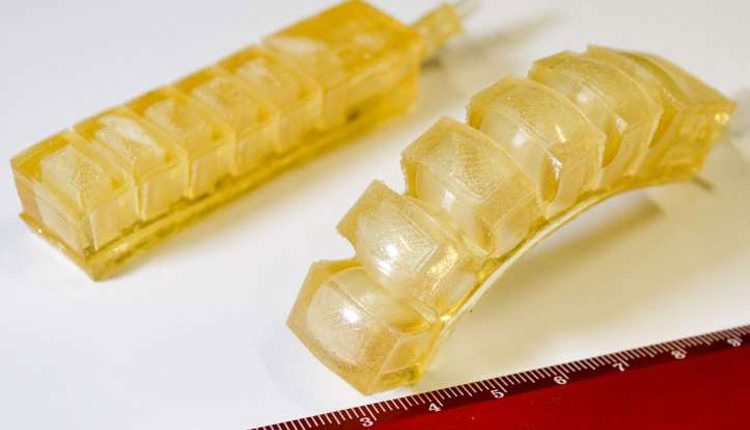Attracting a number of tech watchers, Swiss engineers have been working on an edible robot. The next robot, suggested writers, could be an edible item crawling through your gut.
Machine actuators are the key elements in this undertaking by a team from the Ecole Polytechnique Fédérale de Lausanne (EPFL). The research was led by graduate student Jun Shintake, said Recode. April Glaser reported on Sunday that, “unlike the typical metal joinery that’s powered by a motor, these edible gelatin actuators are filled with air or fluid or react to chemicals, which cause them to move.” (Gelatin is already used safely as an outer layer in medicine capsules available over the counter, said Recode.)
Edible pneumatic actuator? So think gelatinous. Consider that robots would move around the inside of your body. The authors in their paper described the actuator as monolithic, fabricated via a molding process.
Some potential applications they have in mind include digestible robots for medical purposes in humans and animals.
Actually, the researchers have been working with a gelatin-glycerol composite, said The Engineer.
“The actuator is formed of multiple separated chambers, said The Engineer , “which can be selectively inflated by the injection of pressurised air – thereby causing the structure to bend.”
An actuator crawls inchworm-style through the digestive tract or, working together, can create a gripper.
On arXiv, their paper, submitted to the IEEE/RSJ International Conference on Intelligent Robots and Systems 2017, is titled “Soft Pneumatic Gelatin Actuator for Edible Robotics.” Authors are Jun Shintake, Harshal Sonar, Egor Piskarev, Jamie Paik, and Dario Floreano.
The authors wrote that the actuator “exhibits a bending angle of 170.3° and a blocked force of 0.34N at the applied pressure of 25 kPa.” The device measures 90mm in length, 20mm in width and 17mm in thickness.
Andrew Tarantola in Engadget wrote that the actuators can be paired with digestible batteries, cameras and sensor equipment.
Glaser in Recode said the edible gelatin actuator does not have any electronics in it and is fully digestible, and this was according to Dario Floreano, the professor who oversees the Intelligent Systems Laboratory.
The Engineer said that, according to their paper on the subject, the composite they use “exhibits many of the same performance characteristics of the more traditional elastomers used in soft robotics applications.”
What’s next? Recode reported that the gelatin-based actuator is still in its very early stages of development, according to Floreano.
Beyond their work, Glaser noted other advancements in edible electronics. “Ingestible electronics that are already on the market include pills with ingestible sensors on them that can track patient compliance, as well as a camera that is small enough to be swallowed to record activity in a person’s digestive tract to help diagnosis issues, like bleeding, that scopes can’t detect.”
Nonetheless, there is potential in what the EPFL researchers are up to. The authors in their paper stated that “Edible robots can be biodegradable, biocompatible, and environmentally sustainable with none or lower level of toxicity…The (still missing) availability of edible actuators could pave the way to fully edible robots.”


Comments are closed, but trackbacks and pingbacks are open.